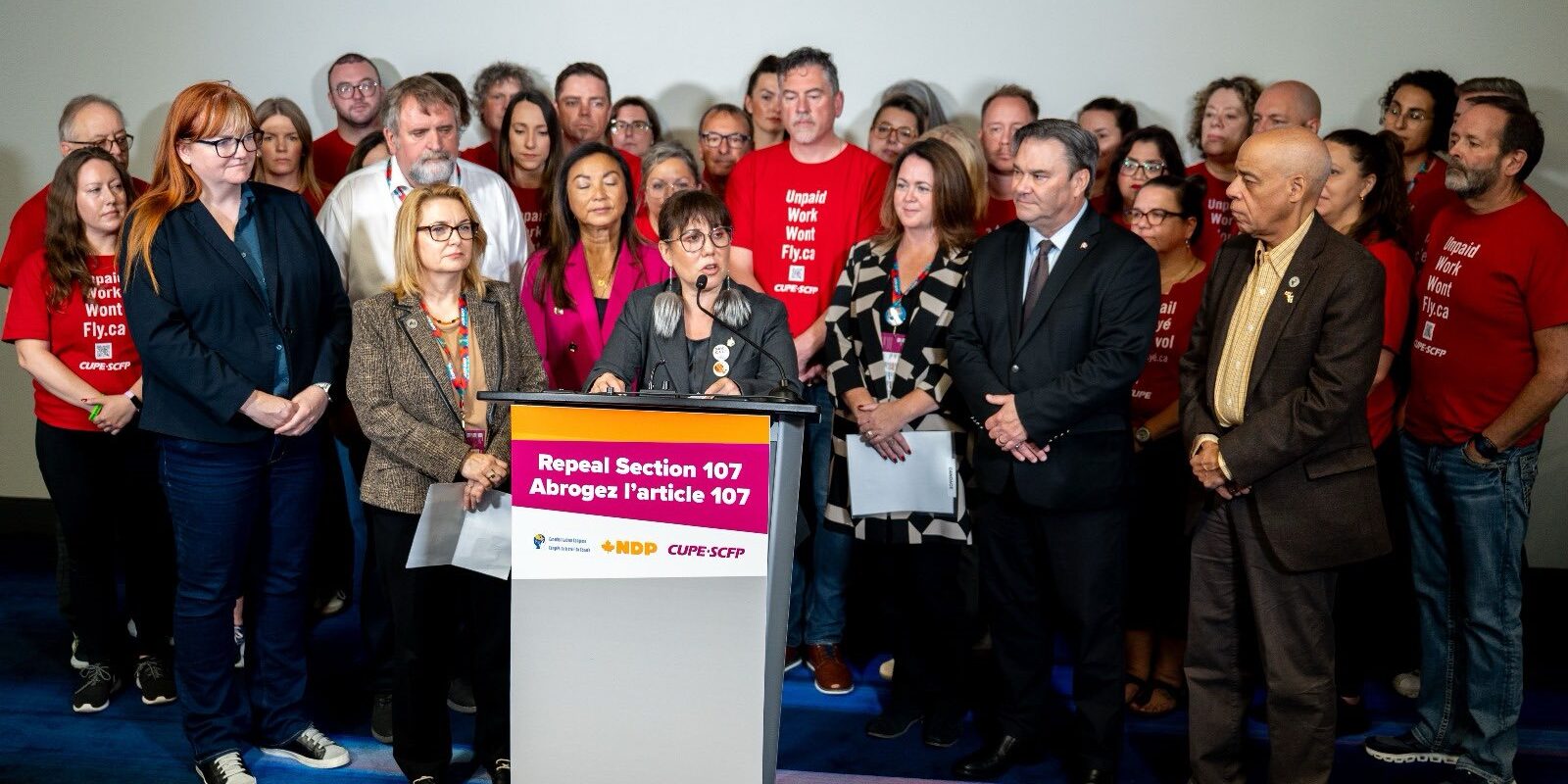The full text of section 107 says that the federal minister responsible for labour may “do such things as to the Minister seem likely to maintain or secure industrial peace and to promote conditions favourable to the settlement of industrial disputes or differences and to those ends the Minister may refer any question to the Board or direct the Board to do such things as the Minister deems necessary.”
Since June 2024, section 107 has been invoked eight times to interfere with bargaining or end strikes, including those by postal workers, flight attendants and railway workers.
“When big corporations complain, the government caves,” Gazan said while tabling the bill on Monday. “This is a direct violation of workers’ rights, the right to strike and the right to free collective bargaining. These rights were won through generations of struggle and sacrifice, yet government after government violates the rights of workers whenever it is politically convenient.”



according to your graph when union membership rates were at their highest was 1957 @ 33% and would would have made the oldest baby boomer 11 years old… interest rates were %3.11 and inflation about 3%
pretty much exactly like today… so no unions did not make it better to buy a house.
I will address some of your points at the beginning and then go to an explanation at the end.
First. Not my graph. The actual data. And to clarify, data from the US, though similar effects occurred in Canada.
First not only are baby boomers homeowners, but so were the greatest and silent generations, see again the US Census data.
Even if the oldest baby boomer was 11 years old (1957 - 11 = 1946 (9 months after VE day) remember the baby boomers got their name from the large increase in births after WWII). Who were making the baby boomers? A “mommy” and “daddy” from the Greatest generation, when “they shared a ‘special’ hug”. And guess what? “mommy” and “daddy” from the Greatest generation also owned their own home. High unionization and the G.I. bill. Unions and Government working together, oh la la. Maybe if the Unions and Government share that “special hug” again another middle class will pop out. This is highly rhetorical, of course.
Interesting point. Union membership was 33% at that time and 9% today but the interest rates and inflation is similar.
Furthermore, in Figure 1 of the Department of the Treasury article (link: https://home.treasury.gov/news/featured-stories/labor-unions-and-the-us-economy):
Percent of income going to the top 1% was about 13% in 1957. From roughly 1972 to 1982 the percent of income the top 1% had is below 11%. Currently the top 1% receive 19% of income. This means when the top 1% of income earners received 1 out of every 9 dollars the oldest baby boomers were between 26 to 36 years old (1972-1946 = 26 to 1982-1946 = 36) these are prime “buy your first house” years. But today the top 1% get about 1 out every 5 dollars. In other words, Baby boomers got 8 out of 9 dollars (89%) while Gen Z get 4 out every 5 (80%) also worth mentioning that out of the bottom 99% getting 80%, the bottom 60% now get less than 20% of income.
The reason why “correlation is not causation” is a thing is because you need a causal mechanism.
You are correct that unionization by itself does not cause wealth nor home ownership. After all union membership is merely an expression of Freedom of Association. But the point of association is its effects. Freedom of Expression is hollow if the effect of petitioning the Government for a redress of grievances, circulate ideas, affect social opinion were not present.
Likewise you can clearly see in Figure 1 of the US Department of the Treasury article shows the inverse affect on the income of the top 1% lags (follows) union membership. Or in a causal way, union density leads (affects), inversely, the income of the top 1%.
Why does this matter?
Because money is not a real resource, it is a relative resource. It is the method by which resources and labour are distributed.
You cannot do anything with money (even Bitcoin) by itself, it is by exchanging it with something else, you can then use that something else to do something. And therefore whoever controls that money can get the something else so that they can get the thing they want done.
So with less money in the top 1%, means less resource attention goes to the top 1% meaning more resources and attention go to the rest of the population.
Hence, it is union membership (freedom of association) -> changes distribution of money (affect of stated freedom) -> exchange money for resource/labour/attention (physical manifestation of the distribution) -> people who are union members or benefit from union density use the resources (materials/labour) to make a house (realization of control and why one owns a house)
Therefore it is the distribution of resources that needs to be looked at. The houses are present and people are living inside of them, why then are these houses not owned by the young population? So they rent or stay at home?
The distribution of resources is downstream from the distribution of money. The distribution of money is affected by power dynamics. Unionization uses the Freedom of Association to affect power dynamics (that is the stated effect of this freedom). In like fashion Freedom of Expression (should) affect Government policy (that is the stated desired effect).
Thus union density is a contributing factor and a pathway to increasing the resource share ownership of workers.
There are other ways, and maybe new ways need to be found with new material conditions made by automation and AI. However, it is up to you to showcase how the distribution of resources can be made more equally (or equitably depending on style) through another mechanism where social relations between people and resources and the power dynamics that occur in a predictable way can be made.
If you care about people not working and getting a pay cheque. Why are you not mad about rent seeking (economic rent and land rents), usury, dividends, etc.? Are you mad that people get something for nothing? Are you mad the Gen Z, in your eyes, don’t work hard and want to get something? If the last two are true, do you attack generational wealth? Of legal monopoly on land, on machines, or future AI?
This bill is just the start, it by no means is the end. There are deeper problems.
Again I have given you the parameters to change my opinion. I urge you to be multi-variate in your historical analysis and showcase how material reality materializes as opposed to one line cliches.
You can’t just say “boomer work hard” and “gen z does not” because when jobs were shipped over seas, a lot of foreign workers worked really hard and didn’t get what the boomers did. They got what the Missionary generation got, bad conditions and low pay. Now they formed unions, went on strike and recently got a pay increase with which they will improve their lives. Example that happened 10 months ago in Bangladesh with textile (clothing/garments) workers (link to AP article: https://apnews.com/article/bangladesh-garment-workers-wage-increase-5d55f9ba52ef2a156069e86dad665662). Thus the relation of freedom of association (union) -> power (strike/bargain) -> more money (relative resource) -> more goods (actual resource). You will now see that this current generation of garment workers will have more than the previous one. Thus Gen Z Bangladesh textile workers will own houses or better houses than their previous generation. Thus it is not “Gen Z” but a fact of material forces, of causes and effects, of power, the abstract and its realization.
You then have to provide a framework that explains the path of development through industrialization. Looking superficially does you, and everyone else, no good.
Again, you can state your states and explanation and falsification like I have or choose to not declare that you are mad about certain anecdotes of unions, which I do not deny.